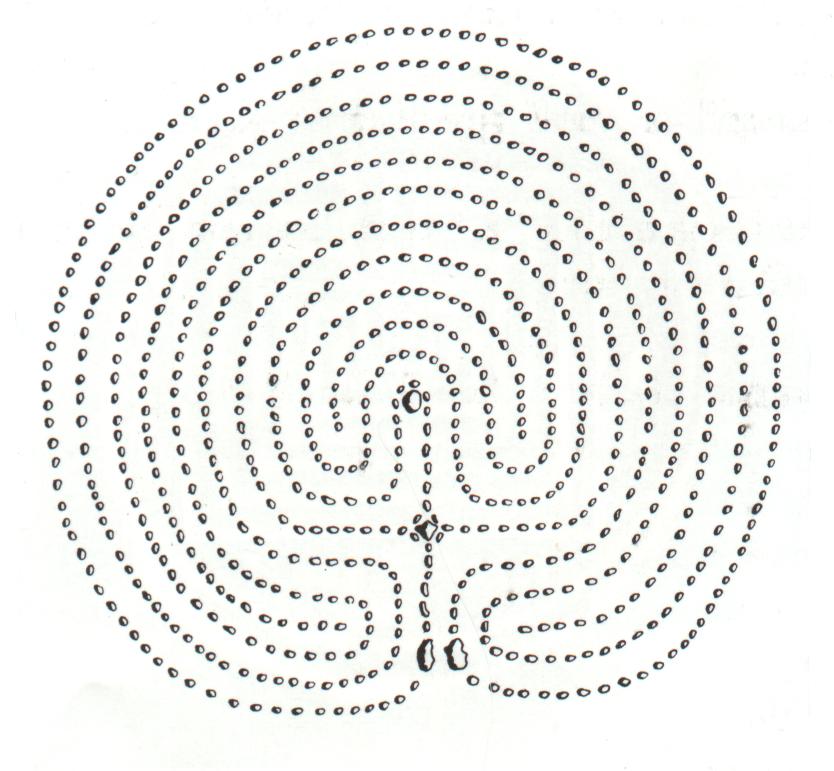Trojaborg Labyrinths
Trojaborg Labyrinths
– A Stone-lined Labyrinth Pattern from the Bronze Age
The Trojaborg labyrinth is the earliest known type of labyrinth. It dates back to the Bronze Age (about 3,000-4,000 years ago). The Trojaborg labyrinths are built of several hundred stones laid in a certain pattern (either 7 circuit or 11 circuit patterns).
These stone-lined labyrinths are found in large numbers in Scandinavia. Most of them in Sweden, where more than 300 Trojaborg labyrinths have been recorded, old as well as more recent examples, preserved or less complete.
In Denmark, there are around 20 modern copies of the Trojaborg stone labyrinths today; however, no historic ones have survived. The reason for this may be that the Danish soil is too rich. The stones may have been removed long ago or have simply disappeared due to lack of maintenance.
The stone-lined Trojaborg labyrinth is a so-called unicursal labyrinth
There are 2 distinctive basic types (according to pattern):
One is the Trojaborg type and the other is the Chartres type.
Many labyrinth ground plans are based on one of these two types.
Common to both types are that when you have reached the goal in the centre,
you have been through all the paths. There are no dead ends. You are led all the way in and out, so to speak. The system is harmonious, it is one continuous pathway.

Why is it called a Trojaborg?
The name Trojaborg dates back about 2500 years ago.
But why do so many labyrinths in the north have the name Troy?
From where does this name derive?
The answer is difficult to define.
First, it should be mentioned that many labyrinths were named after destroyed cities, such as Jericho, Jerusalem, Babylon, Lisbon or Troy. All of these places were besieged and conquered or otherwise destroyed.
This is quite interesting in itself, however, in the Homeric legends of the city of Troy, one should also remember the story of ”Helen of Troy”. Helen of Troy was to be found inside and then taken from the fortress. The Nordic examples of the so-called ”jungfrudans” (Maiden’s Dance) labyrinths can be seen as a parallel to this story. According to the Nordic labyrinth legend, a maiden is placed in the centre of the Trojaborg labyrinth. It was then the young man’s task to enter the labyrinth and rescue her.
A different and probably better explanation is that the word “Troja” might derive from the old Norse word ”at vende / at dreje”. It thus refers to the many turns in the labyrinthine pattern.
In Germany, labyrinths are also called Zauberkreis, Windelbahn or Wendeberg.
In England, they are often called The City of Troy, Julian´s Bower, or Troy Town.
In Wales: Caerdroia.
In Iceland: Völundarhus.
In Sweden: Trojaborg and Drottning Kristinas Ridbana (The riding ground of Queen Kristina), and in Sweden and Finland: Jungfrudans (Maiden’s Dance).

The Cretan Labyrinth Type
The Trojaborg is also called the Cretan type; because the same pattern has been found on coinage from the island of Crete dated around 500 to 100 BC.
The oldest securely datable labyrinth symbol so far discovered is inscribed on a clay tablet. It was found in the ruins of the Mycenaean palace at Pylos in southern Greece, around 1200 BC, in the Bronze Age. On the other side of the clay tablet was a datable text.
So the Trojaborg motive was evidently well-known in Southern Europe. However, it is quite remarkable that there are no stone labyrinths in the Greek, Cretan or Southern European world.
The stone-lined Trojaborg labyrinths are only found in Northern Europe, and mainly in Scandinavia. That’s why Scandinavia is called the classical area for stone-lined Trojaborg labyrinths. However, labyrinths were indeed known in Classical Greece: from rock carvings, and in the Greek myths and legends.

The Magic Trojaborg Labyrinth
Most of the Trojaborg labyrinths in the Nordic countries are not older than 900 years, and have thus been built in Christian times. However, the stories about their purpose and uses are connected with old pagan faith.
Especially people who were particularly exposed to the hazards of nature seemed to have continued to practise their old faith in the labyrinths. In many areas in Finland and Sweden, labyrinths were built and used by people who believed these twisting and winding paths would help them to overcome different difficulties. At several places, these pagan customs have survived into our own century.
Fishermen probably used labyrinths for protection against the perils of the sea, and probably also to increase their catch. They believed that the “little people” could bring bad luck to the fishing, and that using the labyrinth would scare the evil gnomes and give protection against the evil. Lapps and shepherds have used labyrinths for protections against wolves and wolverines, and it seems as if labyrinths have also been used as protection against other threats and as a remedy for mental illness. In fact, they seem to have served a multitude of different magic purposes.
According to local tradition among the people living in the northern Swedish archipelago, a stone labyrinth brings happiness to anyone who succeeds in walking through the twisting path without displacing any of the stones.
That’s why it is important to follow the path of the labyrinth to the centre and out again. If one can manage that, it will bring good luck and success, but bad luck will follow if one jumps over the stone walls.
Modern use
A modern use of Trojaborg labyrinths is for problem solving: Walk slowly to the centre and then out again. On your way in, find a solution to your problem by means of feelings or by intuition. On your way out, face the solution – don’t change your mind – and find out what the solution means to you in practice. When you are out again, you know exactly how to solve your problem!
Holistic Use
The classical seven-circuit labyrinth may also be used as an excellent holistic problem solving device. The paths of the labyrinth can be numbered out-side-in from one to seven. There are many different systems that break things in to seven, one being the 7 chakras. The seven-circuit labyrinth can be used to look at a question you may have, or for working with a problem or opportunity you may be encountering in your life. As you walk each circuit, you deal with a specific way or level of relating to this issue.

Summer solstice celebration with Maypole dance

Maypole dance with red ribbons

The red ribbons are evenly spread

Solstice celebration in our Trojaborg labyrinth

















